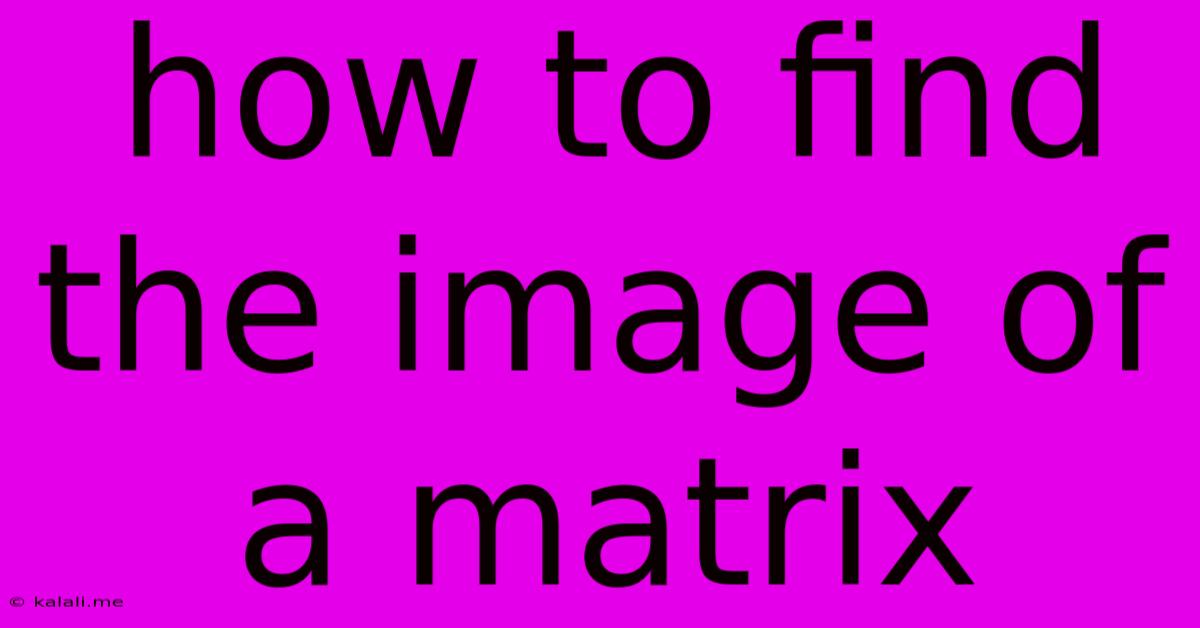How To Find The Image Of A Matrix
Kalali
May 25, 2025 · 4 min read

Table of Contents
How to Find the Image (or Range) of a Matrix
Finding the image (also known as the range or column space) of a matrix is a fundamental concept in linear algebra with applications in various fields like computer graphics, machine learning, and data analysis. This article will guide you through different methods to determine the image of a matrix, explaining the concepts clearly and providing practical examples. Understanding this will give you a deeper understanding of how matrices transform vectors and spaces.
The image of a matrix A, denoted as Im(A) or R(A), is the set of all possible vectors that can be obtained by multiplying A with any vector. In other words, it's the span of the columns of the matrix. This means we're looking for all linear combinations of the columns of A.
Method 1: Using the Column Vectors
The most intuitive method is to consider the column vectors of the matrix. The image of the matrix is the span of these column vectors. This means any vector in the image can be expressed as a linear combination of the columns.
Let's consider a matrix A:
A = | 1 2 |
| 3 4 |
The column vectors are [1, 3] and [2, 4]. The image of A is the set of all vectors of the form:
c₁[1, 3] + c₂[2, 4], where c₁ and c₂ are scalars.
This represents all possible linear combinations of the column vectors. Geometrically, this is the plane spanned by these two vectors. If the column vectors are linearly independent (as they are in this example), the image is a two-dimensional subspace.
Example: Let's check if [5, 11] is in the image of A. We need to find scalars c₁ and c₂ such that:
c₁[1, 3] + c₂[2, 4] = [5, 11]
This leads to a system of linear equations:
c₁ + 2c₂ = 5
3c₁ + 4c₂ = 11
Solving this system (e.g., using substitution or elimination), we find that c₁ = 1 and c₂ = 2. Therefore, [5, 11] is in the image of A.
Method 2: Row Reduction to Echelon Form
Another powerful method involves reducing the matrix to its row echelon form (or reduced row echelon form). The columns corresponding to the pivot positions in the echelon form represent a basis for the image.
Let's use the same matrix A:
A = | 1 2 |
| 3 4 |
Performing row reduction (subtract 3 times the first row from the second row), we get:
| 1 2 |
| 0 -2 |
The pivot positions are in the first column of each row. Therefore, the column vectors corresponding to the pivot positions in the original matrix A (before row reduction) form a basis for the image. In this case, it's just the first column vector [1, 3], and the second column is linearly dependent on the first. Thus, the image is spanned by [1, 3]. Note that while this method identifies a basis, it doesn't explicitly show which linear combinations of the original columns produce the image vectors.
Method 3: Using the Rank of the Matrix
The dimension of the image of a matrix is equal to its rank. The rank of a matrix is the number of linearly independent rows (or columns) in the matrix. This can be determined through row reduction. Once you know the rank, you know the dimension of the image. Finding a specific basis still requires looking at the column vectors, but this provides a quick check of the dimensionality.
Singular Value Decomposition (SVD)
For larger and more complex matrices, Singular Value Decomposition (SVD) provides a powerful approach. The columns of U (the left singular vectors) corresponding to non-zero singular values span the image of A. However, this method is more computationally intensive and usually employed when dealing with very large or high-dimensional matrices.
Finding the image of a matrix is crucial for understanding the transformations represented by the matrix and for applications in various mathematical and computational problems. Choosing the most efficient method depends on the size and complexity of the matrix and the specific information needed. These methods provide a solid foundation for tackling this important concept in linear algebra.
Latest Posts
Latest Posts
-
In Many States Trailers With A Gvwr Of 1500
Jul 10, 2025
-
How Many Tablespoons Are In A Hidden Valley Ranch Packet
Jul 10, 2025
-
Which Is The Best Summary Of The Passage
Jul 10, 2025
-
How Many Quarts Of Soil In A Cubic Foot
Jul 10, 2025
-
What Is 3 4 Of A Pound
Jul 10, 2025
Related Post
Thank you for visiting our website which covers about How To Find The Image Of A Matrix . We hope the information provided has been useful to you. Feel free to contact us if you have any questions or need further assistance. See you next time and don't miss to bookmark.